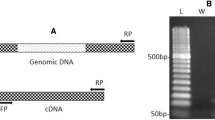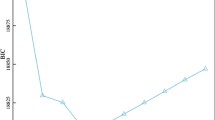Abstract
In microarray experiments, the global and the specific gene expression in the two-way table of gene x treatments (or tissues) can be studied using linear-bilinear models that incorporate the main effects of genes (G), treatment (T), and gene x treatment interaction (G x T). The plot of the first two axes obtained from the singular value decomposition of the bilinear (multiplicative) term of these models (biplot) facilitates the interpretation of the gene expression patterns. In this study, two microarray datasets were used to illustrate how two linear-bilinear models, the additive main effect and multiplicative interaction (AMMI) and the treatment regression model (TREG) and their biplots can be used to determine the overall gene expression pattern across treatments (or tissues) and for specific treatments. Dataset 1 had 5,339 genes and the objective was to identify genes with modified expression during maize (Zea mays) seed development in response to different parental ploidy levels. In Dataset 2, the aim was to study gene expression in 15 tissue samples with different levels of development of breast cancer when compared with the expression of the genes in noninfected tissues. The results from the analyses of Dataset 1 showed that the biplots of the AMMI and TREG models allow identification of subsets of genes and treatments with noncrossover G x T interaction or with important levels of crossover G x T. Results from Dataset 2 showed that the TREG model and its biplot facilitates the identification of genes with high expression in all tumor cells. Also, the TREG biplots allowed identification of subsets of genes with a low level of gene x tissue crossover interaction.
Similar content being viewed by others
References
Alter, O., Brown, P. O., and Botstein, D. (2000), “Singular Value Decomposition for Genome-Wide Expression Data Processing and Modeling,” in Proceedings of the National Academy of Science, 97, pp. 10101–10106.
Alter, O., Brown, P. O., and Botstein, D. (2003), “Generalized Singular Value Decomposition for Comparative Analysis of Genome/Scale Expression Datasets of Two Different Organism,” in Proceedings of the National Academy of Science, 100, pp. 3351–3356.
Baird, D., Johnstone, P., and Wilson, T. (2004), “Normalization of Microarray Data Using a Spatial Mixed Model Analysis Which Includes Splines,” Bioinformatics Advance Access, published July 1, 2004. DOI: 10.1093/ bioinformatics/bth384.
Burgueño, J., Crossa, J., Grimanelli, D., Leblanc, O., and Autran, D. (2005), “Spatial Analysis of cDNA Microarray Experiments,” Crop Science, 45, 748–757.
Chapman, S., Schenk, P., Kazan, K., and Manners, J. (2001), “Using Biplots to Interpret Gene Expression Patterns in Plants,” Bioinformatics, 18, 202–204.
Cornelius, P. L., Crossa, J., Seyedsadr, M. S., Liu, G., and Viele, K. (2001), “Contributions to Multiplicative Model Analysis of Genotype-Environment Data,” in Proceedings of the Statistical Consulting Section, Alexandria, VA: American Statistical Association. CD-ROM.
Crossa, J., Cornelius, P. L., and Yang, W. (2002), “Biplot of Linear-Bilinear Models for Studying Crossover Genotype x Environment Interaction,” Crop Science, 42, 616–633.
Crossa, J., van Eeuwijk, F., Vargas, M., and Cornelius, P. L. (2001), “Linear, Bilinear and Linear-Bilinear Models for Analyzing Genotype x Environment Interaction,” in Proceedings of the Statistical Consulting Section, Alexandria, VA: American Statistical Association. CD-ROM.
Gabriel, K. R. (1978), “Least Squares Approximation of Matrices by Additive and Multiplicative Models,” Journal of the Royal Statistical Society, Series B, 40, 186–196.
Garcia, N., Salamanca, F., Astudillo de la Vega, H., Curiel-Quesada, E., Alvarado, I., Grados, C., and Arenas, D. (2004), “A Molecular Analysis by Gene Expression Profiling reveals Bik/NBK over expression in Sporadic Breast Tumors of Mexican Females Samples,” submitted to Breast Cancer Research.
Gauch, H. G., Jr. (1988), “Model Selection and Validation for Yield Trials with Interaction,” Biometrics, 44, 705–715.
Gollob, H. F. (1968), “A Statistical Model Which Combines Features of Factor Analytic and Analysis of Variance,” Psychometrika, 33, 73–115.
Leblanc, O., Pointe, C., and Hernandez, M. (2002), “Cell Cycle Progression During Endosperm Development in Zea mays Depends on Parental Dosage Effects,” Plant Journal, 32, 1057–1066.
Mandel, J. (1969), “The Partitioning of Interaction in Analysis of Variance,” Journal of Research of the National Bureau of Standards, Series B, 73, 309–328.
— (1971), “A New Analysis of Variance Model for Nonadditive Data,” Technometrics, 13, 1–18.
McLachlan, G. J., Bean, R. W., and Peel, D. (2001), “A Mixture Model Based Approach to the Clustering of Microarray Expression Data,” Bioinformatics, 18, 413–422.
Pittelkow, Y. E., and Wilson, S. R. (2003), “Visualisation of Gene Expression Data—the GE-plot, the Chip-Plot and the Gene-Plot,” Statistical Applications in Genetics and Molecular Biology, 2, 1–17.
Wall, M. E., Dyck, P. A., and Brettin, T. S. (2001), “SVDMAN-Singular Value Decomposition Analysis of Microarray Data,” Bioinformatics, 17, 566–568.
Williams, E. J. (1952), “The Interpretation of Interactions in Factorial Experiments,” Biometrika, 39, 65–81.
Wouters, L., Gohlmann, H. W., Bijnens, L., Kass, S. U., Molenberghs, G., and Lewi, P. L. (2003), “Graphical Exploration of Gene expression Data: A Comparative Study of Three Multivariate Methods,” Biometrics, 59, 1131–1139.
Zobel, R. W., Wright, M. J., and Gauch, H. G., Jr. (1988), “Statistical Analysis of a Yield Trial,” Agronomy Journal, 80, 388–393.
Author information
Authors and Affiliations
Corresponding author
Rights and permissions
About this article
Cite this article
Crossa, J., Burgueño, J., Autran, D. et al. Using linear-bilinear models for studying gene expression × treatment interaction in microarray experiments. JABES 10, 337–353 (2005). https://doi.org/10.1198/108571105X58216
Received:
Revised:
Issue Date:
DOI: https://doi.org/10.1198/108571105X58216




